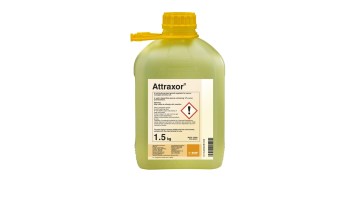New PGR helps restore iconic rugby pitch
26.10.2020
Gloucester Rugby Head Groundsman, Stuart Lambert, has had a whirlwind first two years at Kingsholm. His arrival in 2018 came shortly after the pitch moved to a new Hero Hybrid system. Since then he has had to maintain one of rugby’s most iconic pitches through some of the most extreme weather conditions recorded in the UK and a global Coronavirus pandemic.
Stuart started at Gloucester rugby in August 2018. The new pitch was installed in June of the same year but would not be played on until 1st September. “The aim was to create a more consistent pitch for a fast-flowing game. It is the first hybrid pitch I have ever worked on so since day one I have been learning and adapting to how it plays,” he says.
This season he has chosen to use north_east Attraxor , a new PGR that was recommended by Mark Allen from Agrovista. Stuart also spoke to Adam King, Head Groundsman at Oxford United Football Club, who was one of the first to use the product following its launch at BTME in January. “It appealed to me because PGRs are a significant part of my overall maintenance strategy to improve the turf and control Poa annua. 2020 has been a particularly challenging year for Poa so I was keen to see what Attraxor could offer. Speaking to Mark and Adam gave me the confidence to try it and the results have been far better than expected,” he says.
Stuart has previous rugby experience and worked as part of the Worcester Warriors team. “We won Grounds Team of the Year in the 2014 IOG awards, when I was at Worcester. It was a great feeling to be part of the winning team. Last year Gloucester reached the final and my team and I were honoured to be runner up to Northampton,” he says. Stuart has replicated a programme he operated at Worcester and attributes some of his success to this. “I use liquid throughout the year but intersperse with a granular application too. Liquid works best in the summer months to give the grass the strength it needs to hold out through the tougher winter months when the weather turns colder and wetter, especially the bio stims and seaweed.” Stuart switches to autumn and winter granular applications in October. “I will use the quick release granular feeds until March when we swap it out for a controlled release H-coat feed,” he says.
The construction of a new south stand in 2007 significantly reduced the amount of sunlight to the pitch. “In the winter months almost, the whole pitch is in shade because the stand is so high,” says Stuart. “This has been a big factor for the care programme I have chosen to adopt,” he adds. Maintaining grass coverage is a constant concern in the lower light months and the thinning grass often gives way to Poa annua in the spring which takes hold. “It’s a tricky combination to contend with. The lack of light, winter thinning and then the Poa means the turf is high maintenance. Couple this with the winter months being heavy use and it means we are regularly out with pitch lights to encourage growth in match torn areas,” he says.
Wet weather and the abrasive effect rugby have on the pitch leads to deep divots. Following matches there is a significant recovery process that Stuart must go through to ready the pitch for the next fixture. “I spend time over seeding. In the summer I use a seed mix that provides density and a hard-wearing sward. The main benefit is that it recovers well from matches,” he explains. “Through the colder months I use a mixture which has a Tetraploid cultivar to help it germinate at low soil temperatures,” he adds. Divots are a big concern and so Stuart relies on this mixture to help with winter divot repair. “I also use a light sand dressing to fill any slight hollows and high wear areas. I have learned that with these types of pitches it is important to keep the fibres upright to maintain stability,” he says.
2020 has been a particularly challenging year for Stuart and his team at Gloucester because the ground was closed due to the Coronavirus pandemic. “It was frustrating and came a crucial time of year. We have not been able to carry out a full clean out this year and we had no idea if, or when, the season was going to restart. The pitch maintenance programme was altered to take account of the resources available to us during lockdown and when full access for myself and my team was made available again we had our work cut out to restore the pitch to the expected standard,” he says.
A major concern for Stuart was the increased Poa annua during the lockdown. “The Poa has led me to re-evaluate our overall strategy, especially with the impact that the lockdown has had,” he says. The last match before lockdown was played on 7th March. “The pitch was recovering from winter well at that point and we were starting to get more light in to the ground,” says Stuart. However, lockdown saw the driest period of spring weather ever recorded in parts of the UK and the pitch suffered the consequences. “We carried out a small renovation on 10th June which included verti-cutting in several directions. We lightly scarified and raked in several directions to clear out as much debris and organic matter as possible. It was over seeded, we deep verti-drained and added 60 tonnes of sand as a light dressing across the whole pitch to fill in any areas that were affected following the last match,” he says. “16 bags of C-Complex fertiliser and 20 bags of soil conditioner were also applied before we resumed our normal maintenance programme,” he adds.
On 21st July Stuart applied 1.1 kilos per hectare of Attraxor with 20kg of 46-0-0 nitrogen fertiliser. Attraxor contains prohexadione-calcium, a new active ingredient that regulates growth and also claims to limit the spread of Poa annua by reducing seed-head production. “It visibly weakened the Poa. It looked stressed but the rye around it looked good. It turned the seed heads brown,” he says. Following the first application Stuart feels confident that Attraxor will form an important part of his overall maintenance plan. “It is good to have a product that strengthens the sward and improves density whilst weakening the Poa. I intend to apply it again this season before the temperatures drop but I expect I will use a slightly lower dose in autumn,” he concludes.

